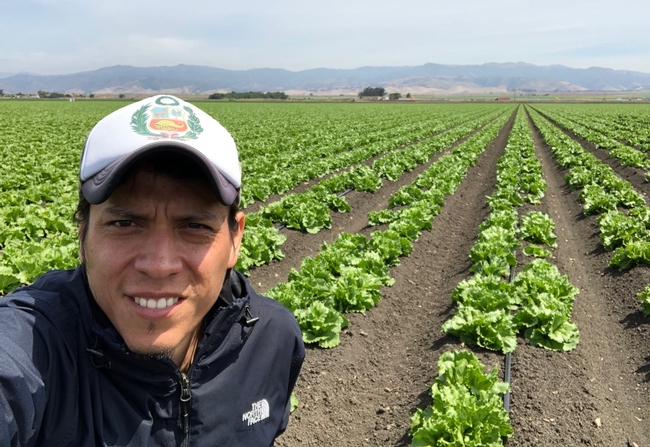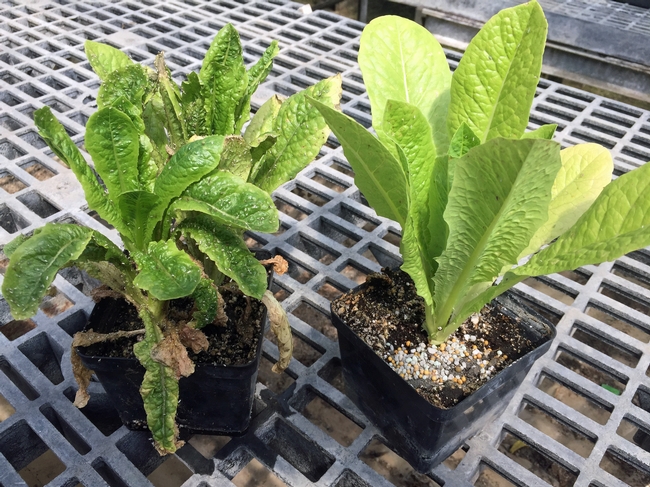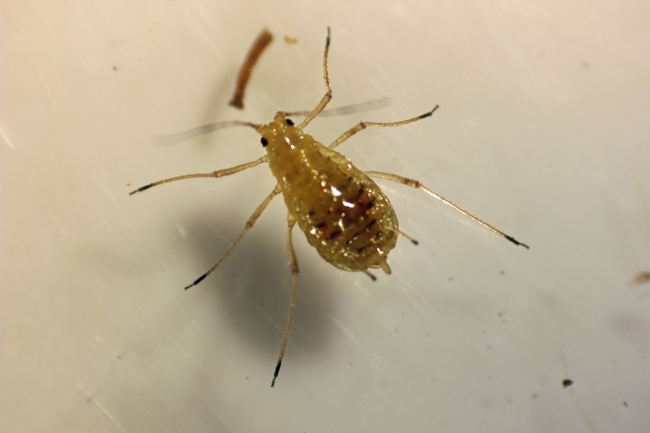Posts Tagged: lettuce
Research Entomologist to Discuss Enemy of Lettuce: Thrips
They're small, about 1 mm long or less, with characteristic fringed wings. They fly, but not well. But thrips do pack a powerful...
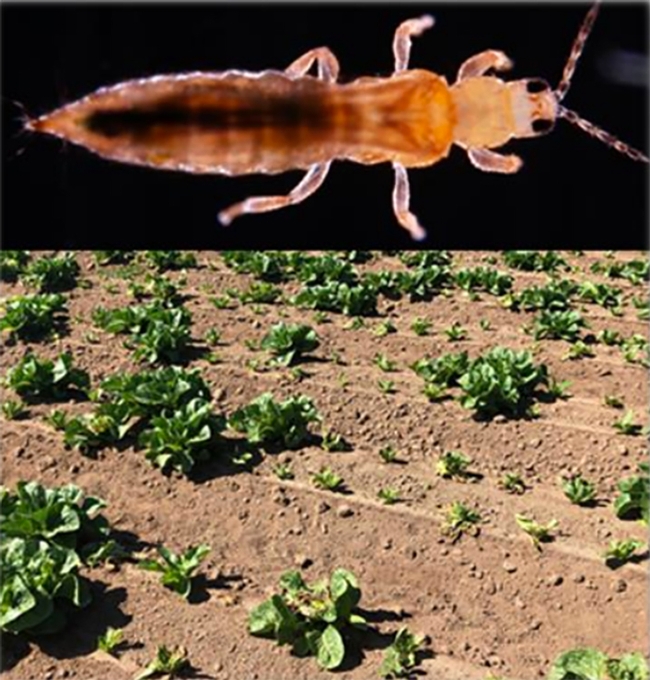
Thrips is a major pest of lettuce production in Salinas. (Illustration courtesy of Daniel Hasegawa)
UCCE advisor is tracking down answers to a lettuce aphid mystery
When Alejandro Del Pozo-Valdivia started his new job as UC Cooperative Extension entomology advisor in the Salinas Valley last year, he immediately faced an urgent problem in organic lettuce production.
Pest control advisers were finding lettuce aphids in plants that were supposed to be resistant.
Because lettuce aphids crawl deep within the heart of the lettuce head, and because organic growers do not have many options for chemical pest control, the industry relies on patented lettuce varieties that have been conventionally bred to be unpalatable to the pest.
“With other types of aphids, they stay on the outer leaves. When you harvest and clean the head, you are taking the aphids out,” Del Pozo-Valdivia said. “But with the lettuce aphid, it's almost impossible to remove them. We don't want consumers to buy a lettuce with these tiny red insects inside.”
Organic producers pay a premium for resistant seeds to grow lettuce without the lettuce aphid and are mystified by the sudden appearance of the pest inside lettuce heads. Has the aphid developed the capability to feed on resistant varieties? Is there a different lettuce aphid biotype in the area? Since Del Pozo-Valdivia is an entomologist, he is focusing on the pest.
With funding from the California Leafy Green Research Board, Del Pozo-Valdivia and his co-principal investigator, USDA scientist Jim McCreight, have launched a research project to collect and identify the lettuce aphids that are feeding and reproducing in the resistant lettuce in the Salinas Valley.
“I'm asking growers and PCAs to contact me if they find any red aphids in resistant lettuce so we can confirm the type of aphid,” Del Pozo-Valdivia said. “
Seed companies that hold the patent on resistant lettuce also experienced broken resistance in Europe a few years ago, Del Pozo-Valdivia said. They found that the pest in Europe was a different biotype and are already working on identifying genes to maintain the lettuce aphid resistance.
“We haven't seen any scientific report for the U.S. That's why we decided to take the lead. To take the bull by the horns and identify the aphids here in the Salinas Valley,” Del Pozo-Valdivia said.
Short video on biological control by USDA scientist Eric Brennan
Click here: Biological Control Buffet in the Salad Bowl of America Dr. Eric Brennan: "Last month I gave a presentation at a national...
Taking Lettuce for a Spin
I have never been a gadgety kind of person. I think I was one of the last people in Solano County to get a cell phone and we still have a small TV that works very well. So it is very surprising that I am going to be extolling a gadget on my turn to blog. And it's not even a gardening gadget, technically anyway. Here is the story: I started growing lettuce during the winter several years ago, first in pots and later in my raised beds. I grew both head lettuce and leaf lettuce, but no matter how I tried, I could not get it to be crisp and supple like what I get at the supermarket.
I tried multiple techniques and too often the leaves ended up limp or dried out. I even separated each leaf from a head lettuce, washed it and laid it between two strips of paper towels or dish towels. This took an enormous amount of space in the refrigerator and lettuce leaves would fall out on the floor as I transferred the stack from the frig to the counter. Sigh.
Then I discovered the salad spinner! This is clever device which spins the excess moisture out of the leaves of lettuce, or kale, or spinach, after they have been washed. Next the whole thing can go in the frig and be stored there til you are ready to make your salad. The leaves have stayed crisp for several days which is good since it is just my husband and me. No mess, no fuss, and it is kind of fun to push the spinner. Add to that I have heard that I can also use the spinner to get out some of the excess moisture when I do my felting projects, shortening the drying time. How cool is that?
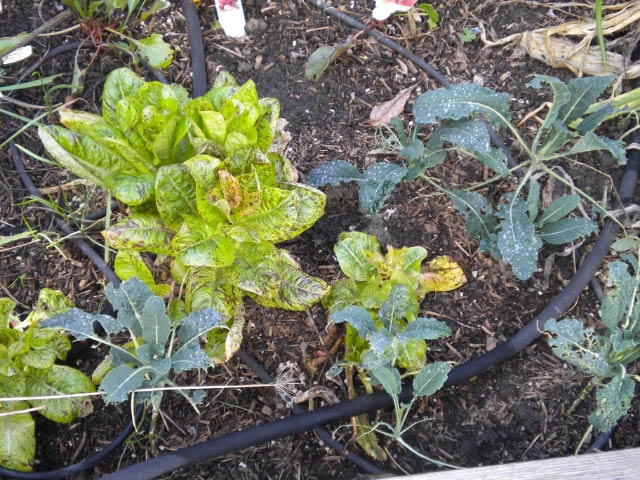
lettuce in the yard
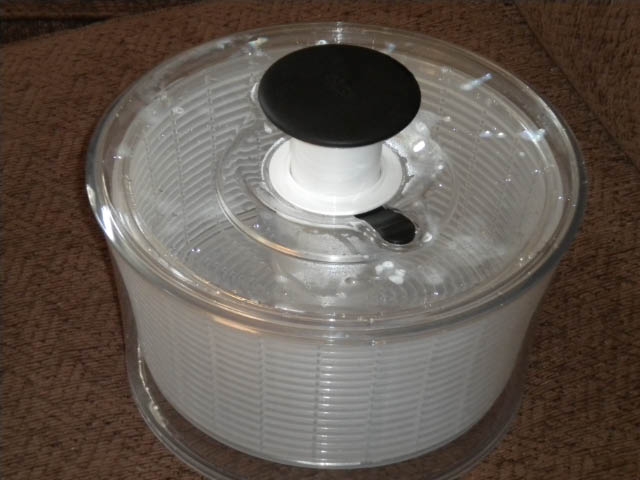
salad spinner
Integrated approach can reduce the risk of Fusarium wilt in lettuce
In a comprehensive study published in the January-March 2012 issue of the University of California’s California Agriculture journal, researchers evaluated the myriad factors that contribute to crop damage from Fusarium wilt, and conclude that an integrated management approach is most effective.
“Management of Fusarium wilt requires an integrated approach that includes crop rotation to reduce soil inoculum levels and the use of resistant cultivars during the warmest planting windows,” wrote UC Davis plant pathology professor Thomas Gordon and co-authors.
Lettuce is the fifth most valuable agricultural commodity in California, with a farm-gate value of over $1.7 billion in 2009.
Fusarium wilt affects all major lettuce production areas in California and Arizona. Caused by a soilborne fungus, it was discovered in California in 1990, when plants with symptoms that ranged from mild stunting to complete collapse were observed in fields near Huron, in the San Joaquin Valley. Diseased plants have severely rotted taproots.
Crop rotation. While soil fumigation can eradicate the Fusarium fungus, the authors note that reintroduction remains a significant risk and routine preplant fumigation is generally not an option for lettuce because of costs and regulatory restrictions. “Consequently, growers must rely on the attrition of inoculum that occurs naturally when nonsusceptible crops are grown instead of lettuce.”
To estimate the longevity of pathogen propagules, the researchers transported soil from a naturally infested commercial lettuce field in Arizona to establish microplots at the University of Arizona's Yuma Agricultural Center. After 6 and 12 months, the density of the Fusarium fungus had declined by 71 percent and 86 percent, respectively. After 34 months, the fungus was detectable at 0.5 percent of the starting population.
“These results imply that keeping a field free of a susceptible crop for a year should dramatically reduce the density of pathogen inoculum — provided there is no significant reproduction on weeds or a rotation crop — but that the pathogen will likely persist at a low level for at least several years,” Gordon and co-authors wrote in California Agriculture journal.
Field susceptibility. To assess the progression of Fusarium wilt under field conditions, the researchers established an infested plot on the Department of Plant Pathology’s research farm at UC Davis.
The field trials revealed significant differences between cultivars in susceptibility to Fusarium wilt. At three weeks after planting, two leaf lettuce cultivars (Lolla Rossa and Red Rossa) and three romaine cultivars (Caesar, Green Forest and King Henry) had low disease-severity ratings and appeared resistant. Two crisphead lettuce cultivars (Beacon and Early Queen) were highly susceptible, and three other crisphead cultivars (Grand Max, Kahuna and Salinas) were intermediate between these extremes.
By six weeks after planting, differences among the crisphead lettuce cultivars had largely disappeared. Although Salinas and Grand Max were more resistant to Fusarium wilt than other crisphead lettuce cultivars, their level of resistance appeared insufficient to prevent severe damage. On the other hand, leaf and romaine cultivars retained low severity ratings until the end of the season.
Air temperature. Air temperatures also played an important role in disease development. In the field trials at UC Davis, Fusarium wilt developed more rapidly in the first (June) trial than in the second (July) and third (August) trials. Air temperatures were highest during the June planting, with a mean daily high/low of 99°F/59°F. They were progressively lower during trials in July, 95°F/55°F, and August, 90°F/52°F. Additional temperature tests in controlled environment chamber confirmed a significant effect of temperature on the development of Fusarium wilt, with disease being most severe at the highest temperatures.
Genetic research. The research team has identified additional resistant romaine and red leaf cultivars and begun developing populations to determine the genetic basis of their resistance. Likewise, breeding is under way to transfer the resistance genes from highly resistant crisphead cultivars to less resistant types.
“The process is time consuming, so it will be several years before highly resistant crisphead cultivars are available,” the authors note. “In the future, highly resistant cultivars of multiple types will be available for vulnerable production areas and warm periods of the season.”
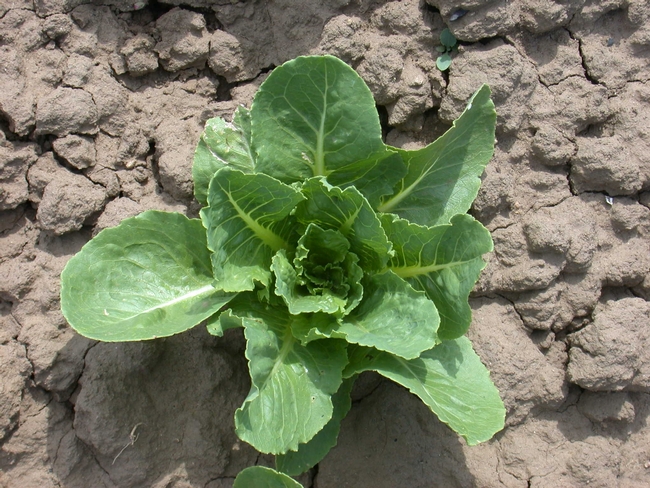
In soils infested with the Fusarium fungus, 'Caesar' lettuce was highly disease resistant.


